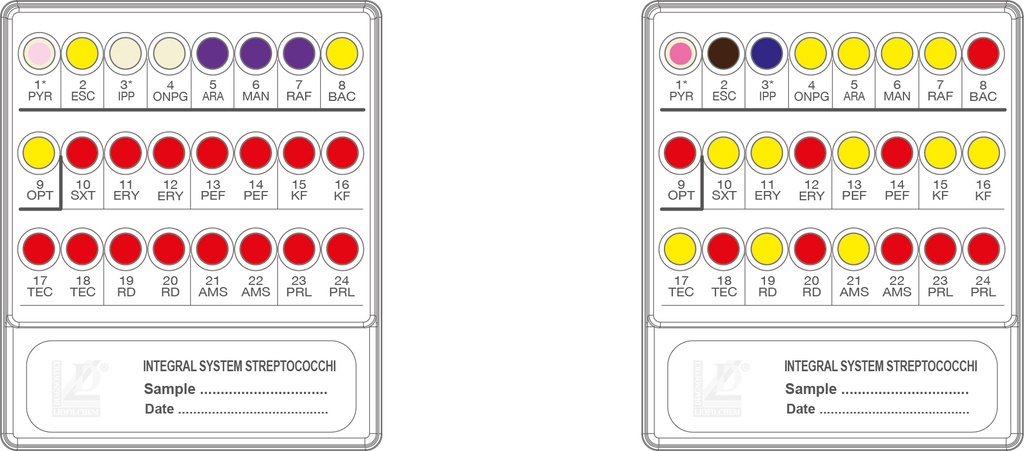Specifications:
| Application | Microbial Identification/AST | ||
| Storage Temperature | 2-8°C | ||
| Product Type | Microbial ID System | Forms | Kit with Various components |
| Product Brand | Liofilchem | ||
| Product Grade | Microbiology grade | ||
The Liofilchem® Integral System Streptococchi is an advanced 24-well colorimetric testing system designed for the simultaneous identification and susceptibility testing of Streptococcal species. The system uses a combination of biochemical reactions and antibiotic susceptibility assays to deliver accurate results within 18-24 hours. This makes it a vital tool for clinical microbiology laboratories and food safety research facilities.
Key Features:
- Comprehensive Biochemical Identification:
- Identifies Streptococci through 9 unique biochemical tests, including:
- Hydrolysis of PYR, esculin, and hippurate.
- Fermentation of arabinose, mannitol, and raffinose.
- Sensitivity to bacitracin and optochin.
- Identifies Streptococci through 9 unique biochemical tests, including:
- Antibiotic Susceptibility Testing (AST):
- Tests against 7 antibiotics, each at two concentrations:
- Erythromycin, Co-Trimoxazole, Pefloxacin, Cephalothin, Teicoplanin, Rifampicin, Ampicillin-Sulbactam, and Piperacillin.
- Tests against 7 antibiotics, each at two concentrations:
- Numerical Code Identification:
- Generates a three-digit numerical code based on the combination of positive and negative biochemical reactions for rapid species identification using a reference table or online software.
- Rapid Turnaround Time:
- Provides identification and susceptibility results within 18-24 hours after incubation.
- Validated and Reliable:
- Every batch is rigorously quality-checked against ATCC reference strains, ensuring high accuracy and consistency.
Specifications:
| Attribute | Details |
|---|---|
| Catalog Numbers | 71720 (20 Tests), 79720 (4 Tests) |
| Detection Time | 18–24 hours |
| Number of Wells | 24 wells per system |
| Applications | Streptococci identification and AST |
| Storage Conditions | 2°C–8°C |
| Organisms Detected | Streptococcus pyogenes, S. pneumoniae, E. faecalis, S. agalactiae, and others |
Kit Components:
| Ref. 71720 | Ref. 79720 |
|---|---|
| 20 Integral System Streptococchi panels | 4 Integral System Streptococchi panels |
| 20 Vials of Inoculum Broth (7.0 mL) | 4 Vials of Inoculum Broth (7.0 mL) |
| 1 Cartridge of PYR-Discs | 1 Cartridge of PYR-Discs |
| 1 Vial of PYR Reagent (5.0 mL) | 1 Vial of PYR Reagent (5.0 mL) |
| 1 Vial of Ninhydrin Reagent (5.0 mL) | 1 Vial of Ninhydrin Reagent (5.0 mL) |
Additional Items Required (Not Included):
- Physiological Solution (Ref. 20095)
Applications:
- Clinical Microbiology:
- Identify pathogenic Streptococcus species and determine their antibiotic susceptibility.
- Food and Environmental Microbiology:
- Detect and test Streptococci in food samples and environmental samples for safety compliance.
- Research and Academia:
- Conduct microbial studies related to Streptococcal infections and antimicrobial resistance.
How It Works:
1. Preparation of Bacterial Suspension:
- Ensure the microorganism is recently isolated (18-24 hours).
- Suspend one or more colonies from solid culture media in Physiological Solution (Suspension A).
2. System Inoculation:
- Biochemical Identification:
- Add 0.2 mL of Suspension A into wells 1–7.
- Place a PYR-Disc in well 1-PYR.
- Susceptibility Testing:
- Add 50 µL of Suspension A into the Inoculum Broth (Suspension B).
- Add 0.2 mL of Suspension B into wells 8–24.
3. Incubation:
- Cover the system and incubate at 36 ± 1°C for 18–24 hours.
4. Post-Incubation:
- Add reagents as follows:
- PYR Reagent: Add 2 drops to well 1-PYR.
- Ninhydrin Reagent: Add 2 drops to well 3-IPP.
- Wait 15-20 minutes, observe color changes, and interpret results.
Result Interpretation:
- Biochemical Identification:
- Positive and negative reactions in wells 1–9 generate a three-digit code for organism identification:
- 1: First test positive in a group.
- 2: Second test positive in a group.
- 4: Third test positive in a group.
- Positive and negative reactions in wells 1–9 generate a three-digit code for organism identification:
- Susceptibility Testing:
- Observe color changes in wells 10–24:
- Red/Red: Sensitive.
- Yellow/Red: Intermediate sensitivity.
- Yellow/Yellow: Resistant.
- Observe color changes in wells 10–24:
Key Benefits:
- Time-Saving:
- Combines identification and antimicrobial susceptibility testing (AST) in a single system.
- Comprehensive Testing:
- Covers biochemical tests and antibiotics for thorough profiling of Streptococcus species.
- Accurate Identification:
- Utilizes a numerical code system for precise species identification.
- Cost-Effective:
- Reduces the need for separate tests, saving resources and labor.
- Validated Results:
- Consistent accuracy, validated against ATCC reference strains.
Antibiotics Tested:
- Erythromycin (ERY): 1 µg/mL, 4 µg/mL
- Co-Trimoxazole (SXT): 8 µg/mL
- Pefloxacin (PEF): 1 µg/mL, 4 µg/mL
- Cephalothin (KF): 8 µg/mL, 32 µg/mL
- Teicoplanin (TEC): 4 µg/mL, 16 µg/mL
- Rifampicin (RD): 4 µg/mL, 16 µg/mL
- Ampicillin-Sulbactam (AMP): 8-4 µg/mL, 16-8 µg/mL
- Piperacillin (PRL): 16 µg/mL, 64 µg/mL
Validation and Quality Control:
- Validated with ATCC reference strains:
- Streptococcus pyogenes (ATCC® 19615)
- Streptococcus pneumoniae (ATCC® 6303)
- Enterococcus faecalis (ATCC® 19433)
- Streptococcus agalactiae (ATCC® 13813)
Storage and Handling:
- Store at 2°C–8°C in its original packaging.
- Avoid heat and temperature fluctuations.
- Discard expired systems or those showing signs of deterioration.
References:
- Ronald M. Atlas. Handbook of Microbiological Media, 4th Edition (2010).
- Patrick R. Murray et al. Manual of Clinical Microbiology, 8th Edition (2003).
- Edwin H. Lennette. Manual of Clinical Microbiology, 4th Edition (1985).
For Research Use Only:
This product is intended for research purposes only and is not approved for diagnostic or therapeutic use.
- Pack Size: for 20 Tests for 4 Tests




 0
0
